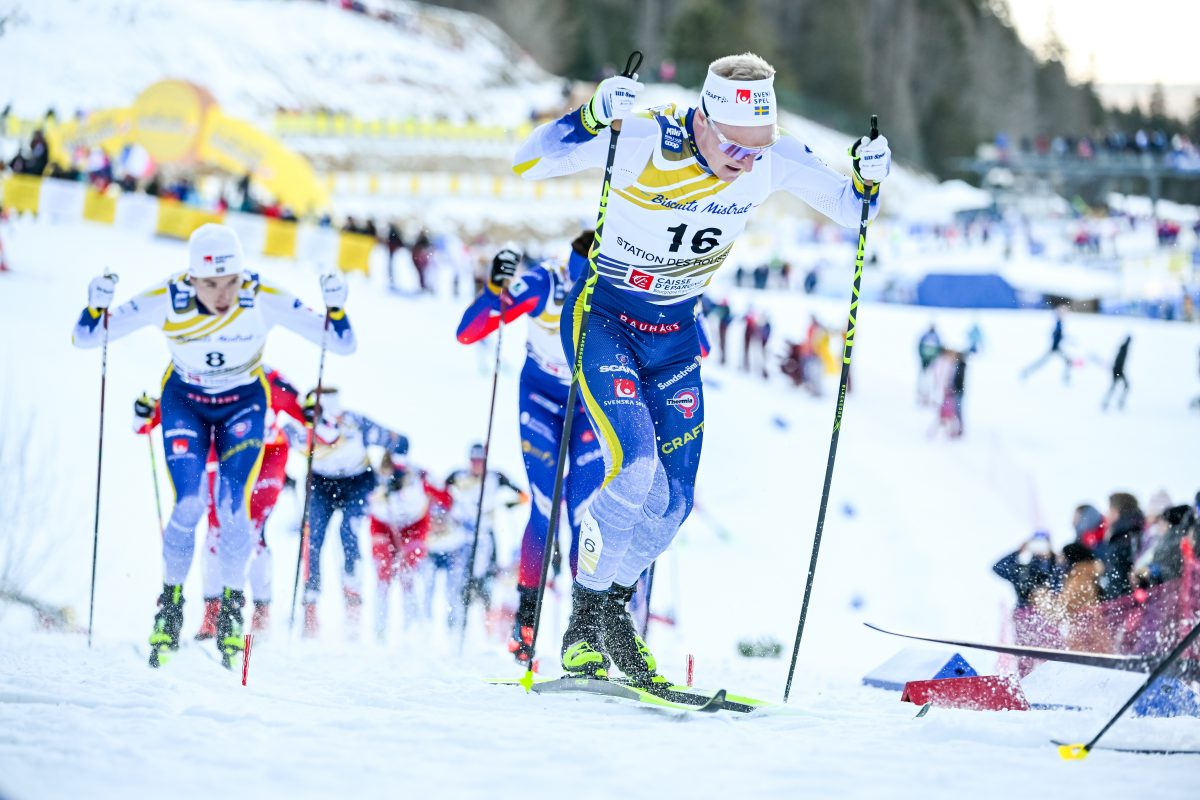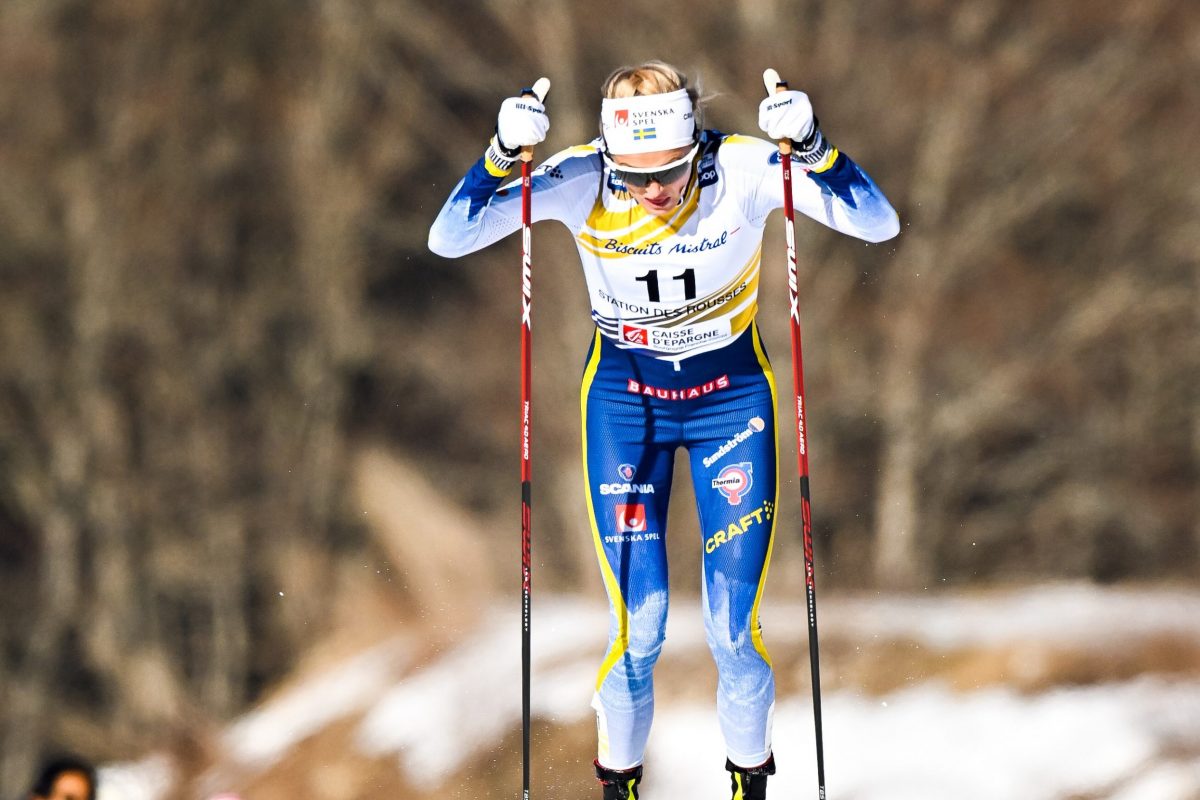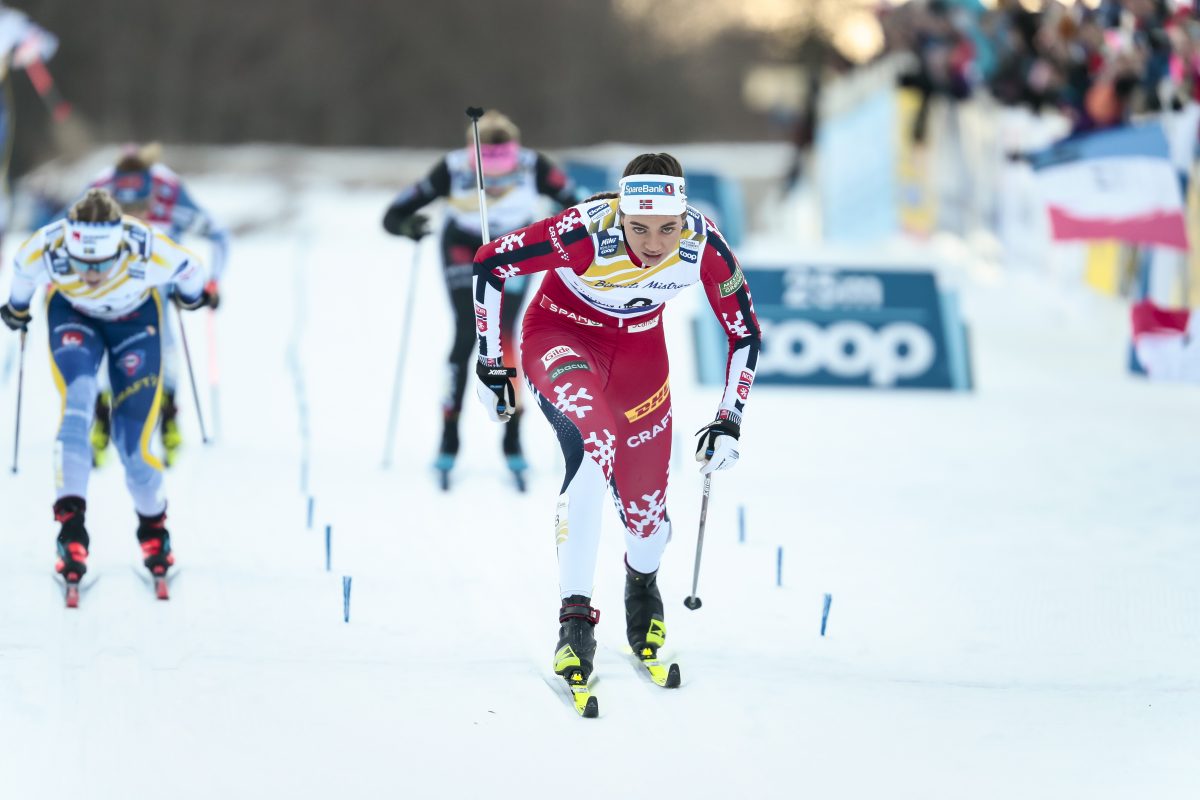As I approached Len Valjas for an interview during a recent junior training camp at his home club in Southern Ontario, I couldn’t help but think something was a bit off – I caught him in the middle of the buffet line, about to load up his plate with pizza. The newest member of the Canadian National Ski Team (CNST) World Cup team was wearing baggy shorts, a big t-shirt, and sunglasses perched atop his head – which at 6’6, was considerably above my own.
After asking if I could chat with him over lunch, he grinned and said “sure, just let me grab my pizza, and I’ll meet you in a minute.”
Here I was interrupting a guy who finished 9th in the World Cup in Drammen, Norway, last season, and has out-gunned some of the best sprinters in the world as he was slumming it in the buffet line with juvenile boys and washed-up former-athletes turned coaches, all the while politely thanking the volunteers passing out food.
Almost exactly a minute later, he folded his lanky frame into a chair next to me, setting down a plate towering with pizza and a big pile of salad, greeting me casually.
The first thing he said? “Man, I was nervous about that presentation last night.”
The previous evening he had given a presentation to the hordes of camp participants about his rise through the Canadian skiing system, and his previous season on the World Cup – I heard via the grapevine it was his first such appearance, and the previous day had heard him joke; “if it goes bad, I’ll just put up some windsurfing video from Hawaii, or something.”

It was far from bad; Valjas, who I have known for the better part of ten years as being a bit of a quiet guy, but you wouldn’t have guessed it from his public-speaking demeanor. He was calm, concise, and had timing that stand-up comedians would kill for.
But the first feeling you get from Valjas (or ‘Lenny’, to most) isn’t one of extreme confidence, or cockiness, which he has probably earned. Valjas’ down-to-earth, earnest attitude was obvious during the aforementioned presentation, particularly when he played the start of his heat at World Championships in Oslo.
The clip shows him doing one double-pole, and then face-planting hard into the snow in front of hundreds of thousands of spectators. During the presentation, he then immediately rewound it, and ran it again in slow motion, unable to keep from laughing as he told the story. (For the record, it earned him the biggest laugh and applause of a very entertaining night.)
And right off the bat, Valjas makes it clear that he comes from modest beginnings as a ski racer, growing up in the suburbs of Toronto, and commuting out to Hardwood Ski & Bike to compete for Team Hardwood.
“I got cut from Team Hardwood’s Devo Squad [junior racing team] as a 12 year-old by Jack Sasseville,” he recalled in his presentation, a story I have heard from him in previous interviews. “I wasn’t serious enough; he was probably right.”
Valjas’ rise to World Cup success has been meteoric. At his first World Cup in 2009 at Whistler Olympic Park he finished 46th, or dead last (“I was dead last by ten seconds; I thought there was a timing error or something,” he quipped); he is now on the CNST World Cup team, and the most striking thing about him is his humble attitude.
“It was kind of unexpected,” he said of his World Cup season, “I was really happy with how it went.”
And obviously so – it was a season most skiers can only dream of. The young Canuck recorded his first World Cup top 30, his first World Cup top 10 (and the corresponding prize money), his first World Championship starts, and to top it all off, even managed to defend his title as Canadian National Sprint Champion in Canmore, Alberta, at Canadian National Championships.
“That was one of the prouder points of the season for me,” he said.
“I was really stoked to defend that [National sprint title].”

While Valjas may be the current National Sprint Champion, and Canada’s fastest pure sprinter, he hardly lords it over people. Instead, he almost seems to revel in fact that he has worked his way up from practically the bottom. In his presentation the day before, his third slide was of his first classic sprint at Nationals in 2004 – where he finished 41st, over 15 seconds behind now-teammate Alex Harvey.
If Valjas was excited about his success Canadian Nationals, the highlight of the season was without a doubt his trip to World Championships in Oslo, Norway.
“I’m not going to forget that ever,” he said. “It’s a totally different atmosphere than I’ve ever been in and I’ll probably never be in an atmosphere like that again.”
Valjas was just happy to be there, to take in the experience.
“To be there just as an alternate I would have been happy – it was nuts.”
And he almost was there ‘just as an alternate’ – the Canadian team used the skate sprint World Cup in Drammen, Norway, the week before World Championships to determine which of their three pre-qualified sprinters (Valjas, Stefan Kuhn, and Phil Widmer) would join Harvey and Kershaw on the start list at the World Championship sprint.
“The pressure was on for sure for all three of us,” said Valjas. “It went by so fast – I one-skated the whole thing. I went across the [finish] line, and I was in the top three for a while.”
Valjas was eventually out-qualified by one other person (less than a tenth of a second behind one Andy Newell) but qualifying in fourth was a shock.
“After finishing fourth I honestly thought there was some kind of timing error again,” he said, laughing, referencing to his first World Cup experience.
“The coaches and staff were all freaking out after I crossed the line – it kind of took me by surprise for sure. Sometimes you need those races just to tell yourself you’re just as good as those guys.”
And Valjas wasn’t just a one-shot wonder on the day; he punched his way through to the semi-final, where he ultimately ended up just missing the A-Final and finishing ninth on the day.
“Going into the heats I kept it going,” he said.
“I had a low bib number, and I’ve never had that, it kind of felt like I fit in, and I knew I could ski the course faster than almost everybody.”
Valjas chalked some of his success up to tactics.
“Everyone else kept shooting out on the [last] turn and I could get inside and make up a few positions there. It kind of worked until the semi, when I ran out of gas,” he said.
For Valjas, the biggest boost he gained from his result in Dramman was confidence – less than six months previous he had been looking up at the top World Cup sprinters in awe, and now he knew he could ski with the best of them.
“Those guys, they’re pretty intimidating,” Valjas said of the men he competes against on the circuit.
“The whole year I kind of walked by them and I would try and name them – you know who they are, but they have no idea who I am. I mean, hopefully now they are starting to know, but I don’t think we should be all intimidated by them.”

And Valjas truly believes that the top level of skiing in Canada is extremely close to that of Europe.
“Our Canadian guys are as fast as those guys,” he said.
“I think Canada is one of the best ski nations now, we just don’t have as many people racing compared to countries like Norway. For the amount of guys we start and the amount of medals we bring in it is amazing.”
Valjas built his confidence up slowly, starting from the moment he set foot in Quebec, and began training with Alex Harvey.
As soon as he started doing workouts with Harvey, he recognized the value in having one the top World Cup skiers doing intensity next to him. He gradually found himself working up to Harvey’s speed, and trying to match him in sprints.
“In training I knew I could be close to Alex, and in races I knew I could do the same thing,” Valjas said.
“A lot of our workouts were replicating sprint races, or sprint heats, and I just knew I had to learn the tactics pretty quick as well.”
And tactics are something Valjas has made an effort to learn, and understand. He called the tactical aspect a “big difference” from North American to European sprint heats.
“Guys are caught surprised,” he said.
“There’s not too much contact, but it’s close quarters, and if you’re not aware of your skis and poles you’re going to get stepped on and tripped.”
“You have to ski small sometimes, you can’t just assume someone is going to be nice and give you space. I’ve always done that, even in NorAm races. I’ve just tried to make sure I stay on my feet, not be super aggressive.
“Once you get better at staying on your feet, you can start being the aggressor, but as soon as you figure that out, it helps, guys aren’t going to start passing you when they aren’t supposed to. If you feel a guy coming up the side, just drift right over, shut the door. Say no, not here,” Valjas explained.
But Valjas hasn’t started being the aggressor quite yet – he still has a lot of respect for his World Cup competitors, and isn’t in a hurry to “piss them off”.

“I also don’t want to be the guy that everyone wants to beat out there, at least not yet,” he said.
Despite the gains he has made tactically in sprinting, he still had some rookie growing pains to go through last season.
Specifically, his trip to World Championships.
Valjas started off his sprint day well, qualifying 21st. As he stood on the start line of his quarter-final, he was soaking up the atmosphere of the thousands of fans as he thought about how proud he was to be a Canadian at that moment.
And then he made a huge mistake – he missed his second pole plant out of the gates, and went crashing onto his face in the tracks.
“The first thought that came into my head was ‘oh crap, this sucks. That’s not how it’s supposed to be. I look like an idiot,’” he said.
But his next thought was a lot more productive – “I just relaxed,” said Valjas, “that was the fastest push-up of my life.”
Luckily, Valjas was able to stay in control and ski smooth to catch up to the group without wasting too much energy. Despite the start, when Valjas crossed the line, he was happy with how the race went.
“It was one of my favourite races, even though it didn’t go as I planned, and my whole game plan was totally blown out the door when I wiped out in the start gate,” he said.
And Valjas has learned from his mistakes – he and the entire Canadian team have dedicated a large portion of time this summer to working on start gates, and sprint starts, something he now feels very confident with.
Valjas was lucky enough to start a second race at World Championships, but it wasn’t without a little controversy.
When Alex Harvey opted out of the relay, it opened the door for some of the other skiers to jump in, albeit with a different mindset.
“It is his decision, that’s what it came down to. Definitely the other teammates didn’t fully agree with it at the time, but that’s his call, he’s got his own goals too,” Valjas said of Harvey’s decision to sit out the relay to save himself for the individual events.
“We didn’t let it bother us, we were going out to race as fast as we could.”

The relay is something Valjas is keen on being a part of on a regular basis – and with the retirement of George Grey, it has become a real possibility, as there is one spot available.
“I would love it to be me,” said Valjas. “It’s one of the most exciting events to race. There’s not so many team events in cross country skiing, so it’s cool to be a part of.
He has switched up his training a little to try and improve his endurance and his distance skiing, and hopes to start a few distance World Cups this season. Last season he started five distance races in total, a number he is convinced is doing little to improve his distance-skiing ability.
“I get better at distance racing by doing more distance races. It’s good training; you can figure out all the pacing and stuff,” said Valjas.
But for Valjas, this season his focus is still sprinting – he hopes to crack the top 30 in the Sprint Cup, and top 50 in the World Cup overall.
He is also thinking about the Tour de Ski – he has a deal with CNST Head Coach Justin Wadsworth where if he notches two top 12’s before the registration deadline, he can decided to race the event or not.
“I’m in no rush to race the Tour,” Vlajas admitted. “I’m still not in the distance and endurance shape that I probably should be to enter that kind of stage race.”
Valjas is feeling confident with the work he has done this summer, as he has been working closely with Wadsworth and Louis Bouchard on improving his fitness and his technical ability.
“I hope this year goes well again, I think I’m in the best shape I’ve ever been in this summer,” said Valjas.
While he may be in the best shape physically, as I wrap up the interview, and Valjas and I collect our dishes and head for the door, I can’t help but notice one thing – he has left his salad untouched. There’s still work to be done.



